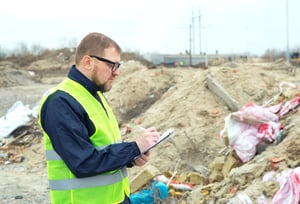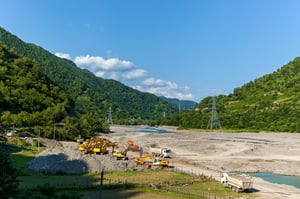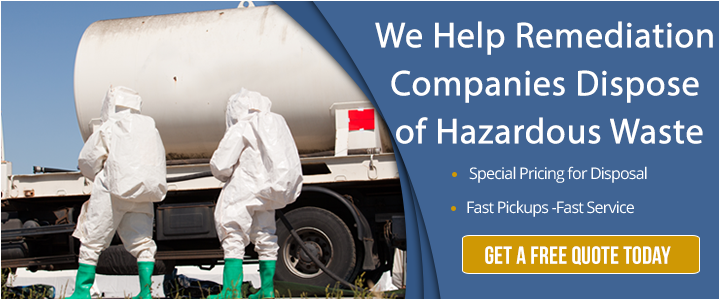Environmental remediation companies face a number of challenges in their efforts to clean up contaminated sites and protect the environment.
From dealing with complex contaminants to ensuring regulatory compliance, here are some of the top challenges for environmental remediation companies:
- Complex contaminant remediation
- Estimating the cost of a project
- Proper disposal of contaminants
- Regulatory compliance and permitting
Complex Contaminant Remediation
Environmental remediation often involves dealing with complex contaminants, from organic pollutants to heavy metals and radioactive materials. Each contaminant requires specific expertise and techniques to effectively remediate a property.
metals and radioactive materials. Each contaminant requires specific expertise and techniques to effectively remediate a property.
Developing and implementing specific strategies to address these contaminants can be a major challenge for crews.
For example, persistent organic pollutants (POPs) like polychlorinated biphenyls (PCBs) and dioxins require specialized techniques due to their persistence, bioaccumulation potential and toxicity. Heavy metals like lead, mercury and arsenic require specific approaches to minimize their mobility and potential for environmental and human exposure. Radioactive contaminants require expertise in radiation safety and specialized handling protocols.
Contaminants can also migrate within the environment into soil, groundwater or sediments. They can also undergo transformation or degradation processes. The behavior of contaminants in different environmental compartments can complicate the remediation process. Companies must understand the migration pathways and transformation mechanisms to effectively contain, treat or remove contaminants.
Complex contaminants may even require the use of multiple remediation techniques to achieve successful cleanup. Every case is different, and environmental remediation companies need to assess the site-specific conditions, contaminant characteristics and remedial objectives to determine the most suitable combination of techniques. These techniques may include processes like:
- Excavation
- Soil washing
- Chemical oxidation
- Phytoremediation
- In-situ bioremediation
There’s also the issue of identifying emerging contaminants like chemicals of concern or microplastics that pose a unique challenge for environmental remediation. These contaminants may have limited regulatory guidelines and established treatment methods, requiring innovative and adaptive approaches. The presence of unknown contaminants or mixtures of chemicals at contaminated sites adds complexity since their behavior and potential risks may not be fully understood.
Estimating The Cost Of A Project
Although environmental remediation projects can be necessary, they can also be expensive due to factors like the extent of the contamination, site complexity and required remediation techniques.
According to the U.S. Environmental Protection Agency, “the parties responsible for the use, transportation, storage and disposal of hazardous substances and oil are liable for costs.” This liability includes the cost of:
- Containment
- Cleanup
- Damages resulting from a release of contaminants related to a company’s activities
While the EPA will work to identify any responsible parties, sometimes they cannot be identified. In this situation, you will be working with the EPA and other participants responding to the remediation project. Estimating the cost of a project is a common task of a remediation company no matter who is funding the project, however.
Several factors can impact cost, and often many of these factors can be challenging to predict. They include:
- Project complexity and scale, including the extent and type of contamination and site characteristics
- Unexpected challenges and regulatory changes during the remediation process that can cause project costs to increase
- Funding sources and competition for available funding, which can be fierce, especially when multiple projects vie for limited resources
- Cost of technological advancements when implementing state-of-the-art technologies
- Insurance and liability considerations in which insurance providers may have strict requirements and may charge higher premiums due to the perceived environmental risks associated with remediation activities
- Cost of long-term monitoring and maintenance to ensure that the site remains clean and safe over time
The proper disposal of contaminants unearthed during the remediation process is another significant challenge in environmental remediation, which we’ll dive into in the next section.
Proper Disposal Of Contaminants
When remediation efforts are under way, the contaminants removed from the site need to be handled and disposed of in a manner that minimizes environmental impact and complies with all state and federal regulations.
in a manner that minimizes environmental impact and complies with all state and federal regulations.
However, just as there are different remediation processes used for different contaminants, there are varying disposal requirements as well. Hazardous chemicals, radioactive materials and other toxic substances must be treated and disposed of appropriately to prevent harm to human health and the environment. Identifying suitable disposal methods for each contaminant can be a complex task.
There are additional challenges environmental remediation companies face when generating large volumes of contaminated material. Proper sorting, segregation and categorization are necessary to ensure appropriate disposal methods are applied.
The availability of disposal facilities can also impact a project, particularly in regions where facilities are limited or distant from the remediation site. This can result in logistical complexities, increased transportation distances and potential delays in project timelines.
That’s why environmental remediation companies often partner with disposal companies experienced to ensure this component of the project is taken care of … often before a project even begins. Waste disposal services will help to ensure your remediation company is well equipped to safely dispose of any hazards a job site poses.
Hazardous waste disposal companies will:
- Remove toxic materials from a remediation site and transport them to the proper disposal facility
- Coordinate the logistics of waste removal, including transportation, documentation and tracking of hazardous materials from the remediation site to the designated disposal facility
- Help properly pack, label and contain the waste to prevent spills, leaks or exposure during transport
- Help to ensure there are no hold ups once remediation services have been completed
- Provide emergency response in case of incidents or accidents during waste removal
- Offer ongoing support and communication to remediation companies, addressing any concerns or challenges related to waste disposal throughout the project’s lifecycle
The best disposal companies will also stay updated on industry best practices, regulations and emerging technologies related to hazardous waste disposal, providing your remediation company with the latest information and options needed for safe waste management.
Regulatory Compliance And Permitting
Environmental remediation projects are subject to a number of regulations and permitting processes at the local, state and federal levels. Navigating through this complex regulatory framework can be incredibly challenging and time-consuming.
Yet failing to comply with regulations can have long-term effects on your business and result in penalties and delays in a project’s implementation.
Obtaining permits for activities like excavation, groundwater extraction, waste transportation and disposal are often required, and the permitting process can involve extensive documentation, environmental impact assessments, public consultations and review periods.
The challenge lies in understanding the specific permit requirements for each project, compiling the required information and navigating the permit application process efficiently to minimize delays.
When navigating the disposal process, it’s also important to note that different jurisdictions - whether at the local or state level - may have different laws outlining whether a waste is hazardous and the disposal methods for that waste. Working with an experienced disposal company can help in this area as well, especially when it comes to disposal laws that are continually evolving.
The best disposal companies will have extensive experience and stay up-to-date on regulatory compliance. This will help your environmental remediation company navigate the complex legal and permitting processes associated with hazardous waste disposal, as well as help to ensure your company is set up for success … from start to finish.


Comment